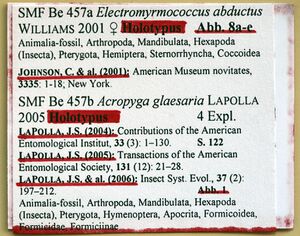Acropyga glaesaria
| †Acropyga glaesaria Temporal range: Burdigalian, Early Miocene Dominican amber, Dominican Republic | |
|---|---|

| |
| Scientific classification | |
| Kingdom: | Animalia |
| Phylum: | Arthropoda |
| Class: | Insecta |
| Order: | Hymenoptera |
| Family: | Formicidae |
| Subfamily: | Formicinae |
| Tribe: | Plagiolepidini |
| Genus: | Acropyga |
| Species: | †A. glaesaria |
| Binomial name | |
| †Acropyga glaesaria LaPolla, 2005 | |
This fossil species, known from at least 4 pieces of Dominican amber, is unusual in that the queens are either clutching mealybugs in their mandibles or have mealybugs nearby. These fossils represent the oldest definitive record of trophobiosis and suggest that this behavior is at least 15-20 million years old, the estimated age of Dominican amber.
Identification
Distribution
This taxon was described from Dominican amber, Dominican Republic (Burdigalian, Early Miocene).
Biology
Associated with the trophobiotic mealybugs Electromyrmoccus abductus, Electromyrmoccus inclusus and Electromyrmoccus reginae.
Castes
 
| |
| . | |
Nomenclature
The following information is derived from Barry Bolton's Online Catalogue of the Ants of the World.
- †glaesaria. †Acropyga glaesaria LaPolla, 2005: 22, figs. 1-3 (q.m.) DOMINICAN AMBER (Dominican Republic, Miocene).
Type Material
Three pieces of Dominican amber with Acropyga inclusions were examined. The exact origins of the amber cannot be known with certainty because the pieces are from mixed mines (D. Grimaldi, pers. comm.).
Holotype queen, from a piece of amber containing the alate queen, with a mealybug specimen nearby (Electromyrmoccus inclusus holotype), deposited in the American Museum of Natural History (= AMNH) (New York, NY, USA) (code no. DR-16-603 in box with amber); 1 paratype queen (wings broken off at the base and not found anyway in the amber) holding mealy bug E. reginae holotype, in amber (AMNH); 2 paratype queens (both alate), 2 paratype males in amber piece with mealybug E. abductus holotype deposited in the Natur-Museum Senckenberg (Germany) (code: SMF VII 169 in box with amber).
Taxonomic Notes
There has been uncertainty as to whether or not the fossils discussed here even belong in Acropyga. For instance, Poinar and Poinar (1999) misidentified an Acropyga fossil as Brachymyrmex. In part, this reflects confusion regarding the taxonomic status, and morphological limits of the genus. A recent world revision of Acropyga revealed seven morphological synapomorphies for the genus (LaPolla, 2004), and these characters were examined on the fossil specimens. Based on those, the fossil is shown to definitively belong to Acropyga, possessing 6 of 7 morphological synapomorphies: incrassate antennae (9-segmented), tubular torulae, 2:3 palpal formula, large and round propodeal spiracles placed dorsolaterally, and the male with 10-segmented antennae (reduced from the primitive 13 segments). The last synapomorphy, a long hair placed medially on the anterior clypeal margin, cannot be scored because workers are needed to properly analyze the character.
Johnson et al. (2001) speculated that the AMNH and Senckenberg (listed as the Frankfurt specimens in their paper) specimens represented different species based on differences in head shape. However, the differences in the posterior margin and posterior corners are not as distinct as Johnson et al. (2001) implied, and some of the observed morphological differences are undoubtedly the result of the amber preservation process. Given that all fossil queens share the same number of antennal segments (9 segments) and have similar morphometric measurements, I feel unjustified in describing more than one species. The number of mandibular teeth is an important diagnostic character that can only be reliably counted on the holotype queen, but the shape of the mandible of all the queens implies that the specimens are conspecific.
Description
References
- Boudinot, B.E., Bock, B.L., Weingardt, M., Tröger, D., Batelka, J., LI, D., Richter, A., Pohl, H., Moosdorf, O.T.D., Jandausch, K., Hammel, J.U., Beutel, R. G. 2024. Et latet et lucet: Discoveries from the Phyletisches Museum amber and copal collection in Jena, Germany. Deutsche Entomologische Zeitschrift 711, 111–176 (doi:10.3897/dez.71.112433).
- LaPolla, J.S. 2005. Ancient trophophoresy: a fossil Acropyga from Dominican amber. Transactions of the American Entomological Society 131: 21-28.
- Varela-Hernández, F., Riquelme, F., Estrada-Ruiz, E. 2024. Elektroformica azquil gen. et sp. nov., a new formicine ant from Oligo-Miocene Mexican amber. Palaeoentomology 7(5), 684-692 (doi:10.11646/palaeoentomology.7.5.11).

